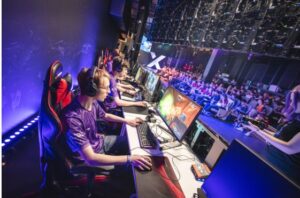From casual gaming to a multi-billion dollar sector with professional leagues, worldwide events, and devoted fan communities, esports has changed. The requirement for sophisticated ideas transcending human intuition increases along with the stakes. Then enter analytics and artificial intelligence (AI), tools transforming team preparation, competitiveness, and success. Examining their effects on gameplay, training, and the direction of competitive gaming, this paper investigates the crucial part artificial intelligence and algorithms play in modern esports.
Looking to elevate your esports experience? Check out ggbet — a leading platform offering betting on over 30 esports disciplines, with secure transactions and competitive odds.

1. The Rise of Data-Driven Strategies in Esports
In traditional sports, data analytics has long been used to optimize player performance and team tactics. Esports, with its inherently digital nature, offers even richer data for analysis. Every click, movement, and decision in games like League of Legends, Dota 2, and
Counter-Strike: Global Offensive (CS:GO) can be tracked and analyzed.
- In-Game Metrics: Teams collect data on player actions, resource management, and in-game decision-making.
- Heatmaps and Positional Analysis: Visual tools like heatmaps help analyze player positioning and map control, crucial in strategy-heavy games.
- Performance Trends: By examining win/loss ratios, kill-death-assist (KDA) statistics, and objective control, teams can identify strengths and weaknesses.
Example: Professional League of Legends teams use detailed match data to refine champion selection, lane matchups, and objective prioritization based on opponents’ past performances.
2. AI-Powered Training and Simulation
AI doesn’t just analyze existing data; it actively helps players improve through advanced simulations and training tools.
- Adaptive AI Opponents: Training against AI that mimics the tactics of top players allows teams to prepare for specific competitors.
- Scenario Simulations: AI can generate countless in-game scenarios to help teams practice responses to rare or complex situations.
- Real-Time Feedback: Machine learning algorithms provide instant analysis of gameplay, highlighting mistakes and suggesting improvements.
Example: Dota 2’s OpenAI Five demonstrated how AI could outperform professional teams by learning optimal strategies through self-play, setting a new benchmark for training tools.
3. Predictive Analytics and Match Outcome Forecasting
Beyond individual performance, AI plays a significant role in predicting match outcomes and optimizing team compositions.
- Win Probability Models: Algorithms analyze historical data to forecast the likelihood of victory based on current game conditions.
- Draft Optimization: In games with character selection phases, AI can recommend optimal drafts based on statistical advantages and counter-picks.
- Live In-Game Predictions: Broadcasters and analysts use AI-generated insights to provide real-time predictions during tournaments.
Example: Esports betting platforms leverage predictive algorithms to set odds, while teams use similar tools to refine strategies mid-tournament.
4. Ethical Considerations: Where to Draw the Line?
While AI and analytics offer undeniable advantages, they also raise questions about fairness and integrity in esports.
- Over-Reliance on AI: At what point does the use of AI diminish the role of human skill and creativity?
- Data Privacy: Teams and players must navigate issues related to the sharing and security of performance data.
- Regulation and Fair Play: Esports leagues may need to establish guidelines on the permissible use of AI and analytics.
Example: The use of real-time analytics during live matches has sparked debates on whether it gives teams an unfair advantage, leading to potential regulatory interventions.
5. Esports’ Future of AI:
Integration of artificial intelligence in esports will only expand as technology develops, therefore influencing the direction of competitive gaming.
- AI-driven coaching systems will provide customized training schedules depending on specific player data.
- Combining VR with AI Synergy potentially transform training approaches by providing immersive, data-rich environments.
- Developers may include artificial intelligence to produce more dynamic, flexible in-game experiences, therefore blurring the distinction between human and machine opponent.
- Future esports events, for instance, might include AI-assisted officiating to guarantee fair play and accurate rule enforcement in real time.
Conclusion
Combining analytics and artificial intelligence is changing the esports scene and giving teams unmatched means to improve their plans and challenge the limits of competitive gaming. This technological development questions the very core of what it means to compete even while it offers new chances. Maintaining the essence of the game will depend on achieving the equilibrium between human creativity and machine accuracy as esports keeps expanding.

